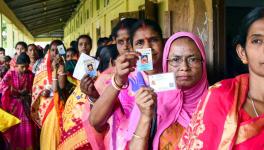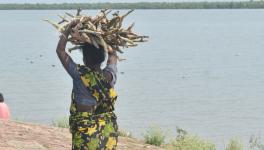Punjab Assembly Elections: Ignoring Economic Issues
Representational use only.
The dates for Assembly elections in five states of the country including Punjab can be announced any time now. The Election Commission has ruled out not holding the polls due to the COVID-19 pandemic. The atmosphere regarding assembly elections in Punjab is getting more and more dramatic day by day. As in many previous assembly elections, promises, claims, and new promises are being made and repeated by various political parties to win the elections.
In fact, most of the claims are hollow and the promises do not go beyond raising hopes. The rewari (a sweet made with jaggery) eaten after the winter meal helps the mouth to taste well and digest the bread. Like many previous assembly elections, the political rewari being distributed in this year's Assembly elections seems to be plastic instead of sugar/jaggery which will spoil the digestion of the people instead of improving it. Often different political parties are promising small concessions to different groups of people but are not giving any roadmap/framework to mobilise the necessary resources to fulfil them. Many promises seem misleading. The worst aspect in this regard is the neglect of important economic issues of Punjab.
The people of Punjab have made great sacrifices in the struggle for the independence of the country and have made significant contributions to the wars against Pakistan. During the 1960s, when the Union Government was facing a dilemma of importing food grains from foreign countries, under PL-480, the country had to pay a huge price for importing foodgrains from the United States of America. Punjab is geographically very small (1.54% of total landmass) but the hard work of brave farmers, agricultural labourers, rural artisans and excessive use of natural resources has saved the country from these problems.
Prior to the 1980s, the financial position of the Punjab government was quite good. The expenses of paramilitary forces deployed by the Union government in Punjab to maintain law and order during the period of militancy was borne by Punjab, while the expense of paramilitary forces deployed in other states of the country during such times was borne by the Central government itself. Due to militancy in the state and preferential subsidies given by the Union government to the hill states for industrial development, Punjab's industrial units have shifted to other states. At present, the Punjab government has a debt of around Rs. 3 lakh crore. This debt of Punjab is creating many unbearable problems for the people living here. During the forthcoming assembly elections, some political parties have been cursing the debt and talking of repaying it, but there is growing frustration over when and how it will be done.
The hard work of Punjab's farmers, agricultural labourers and rural artisans and the over-utilisation of its natural resources has kept the central pool of foodgrains intact, but due to the economic and agricultural policies of the Central government, these three categories are trapped in a debt-trap. Various research studies conducted in Punjab by the author and under his supervision have brought to light the fact that almost all marginal and small farmers, agricultural labourers and rural artisans are born in debt and poverty, they live their hard life in debt and poverty, leaving behind a mountain of debt and abject poverty for future generations, they either die of starvation or commit suicide when all their hope is dashed by the governments and society. A study conducted by the Punjab government under the supervision of professors from Punjabi University, Patiala; Guru Nanak Dev University, Amritsar; and Punjab Agricultural University, Ludhiana has revealed that 16,606 farmers and agricultural labourers committed suicide in Punjab during 2000-2016.
The main reason for these suicides is the debt incurred by these sections. About 40% of these suicides were committed by agricultural labourers. About three-quarters of the suicides committed by farmers are of marginal and small farmers. Debt-ridden unsustainable indebtedness among these agricultural segments is creating many insurmountable problems for these segments. The level of living of these sections is declining. The education of the children of these sections is left in the middle. These sections are forced to live like bonded labourers due to debt. Debt has led to physical abuse of women in these categories, especially agricultural labourers, as well as inhumane activities such as child labour.
Gross Domestic Product (GDP), and per capita GDP is considered an indicator of the economic performance of a country or state. In 1981, Punjab was at the top position in terms of per capita GDP which slipped sharply to 19th position in 2021 and 16th position in terms of GDP. The per capita GDP in Punjab being less than 18 states of the country reflects the deteriorating economic condition of Punjab and most of the people living here. With the exception of a few affluent people in the agricultural, industrial and service sectors of the Punjab economy, the economic condition of most of the people is miserable. Due to very low incomes of marginal, small, semi-medium and medium farmers, agricultural labourers, and rural artisans in the agricultural sector, most of them are stuck in a debt trap and abject poverty.
The economic and agricultural policies of the government have made agriculture a loss-making business, and the use of machinery and herbicides for agricultural production has reduced employment opportunities. Due to militancy and the preferential policies of the Central government towards the hill states, the relocation of industrial units from Punjab to outlying states and some other reasons have led to a sharp decline in employment opportunities in the industrial sector. Employment opportunities in the services sector have increased for some workers who have a level of knowledge of the English language and computers. The quality of employment in this sector is also steadily declining.
Due to low employment opportunities and low quality of employment opportunities in Punjab, young children from the state are migrating to foreign countries. In 2020, researchers Gurinder Kaur, Gian Singh, Dharmapal, Rashmi, and Jyoti conducted a study of international migration from the Patiala district. The study reveals that the international migration of young children from Punjab is emerging as one of the major disadvantages resulting in terms of brain drain, capital drain, and loss of demographic dividend. Most of the young children who are migrating abroad have senior secondary education (12th grade) or higher levels of education. Society has a great contribution towards the education of these children, but it is benefiting the foreign countries. Almost all the young children who are migrating abroad are enrolled in foreign colleges/universities. These children migrate later, but their fees and some other expenses have to be remitted to foreign countries beforehand and after the migration, there is more capital drain to meet the needs of these children. One example in this regard is the properties/lands in Punjab on sale. The high percentage of young children in any country or state is called demographic dividend because these children have to participate in economic activities for a long time. The demographic dividend deficit is clearly visible today and will be even worse in the years to come.
To meet the food needs of the country, groundwater in Punjab has gone down to dangerous levels. The shift from irrigation of wells/canals to irrigation of diesel engines, monoblock motors, and now submersible motors and their number which was only 7,445 in 1960-61 is close to 15 lakh in Punjab is one of the major causes of debt of farmers. This phenomenon is rapidly weakening Punjab's economy.
The number of educational and healthcare institutions in Punjab is increasing rapidly, but this growth is manifested in the expansion of the private sector at the cost of the public sector which ignores the working class. This is also the state of transport in the state.
The time has come for the contesting political parties in Punjab to focus on the economic issues of the state and come up with a blueprint/roadmap for fulfilling their promises instead of distributing plastic rewaris to the people so that Punjab becomes a prosperous state.
The author is a former professor of the Department of Economics, Punjabi University, Patiala. Views are personal.
Get the latest reports & analysis with people's perspective on Protests, movements & deep analytical videos, discussions of the current affairs in your Telegram app. Subscribe to NewsClick's Telegram channel & get Real-Time updates on stories, as they get published on our website.
























